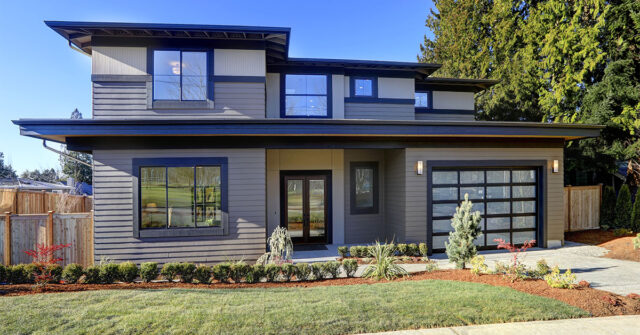Exterior painting is an art and science that requires a comprehensive understanding of various factors.
From the climate conditions to the choice of paint and techniques, every aspect plays a crucial role in the final outcome.
This guide, specifically tailored for the Australian market, aims to provide insights into effective exterior painting, ensuring a finish that not only looks great but also withstands the test of time.
Understanding the Australian Climate
Australia’s climate is diverse, ranging from tropical in the north to temperate in the south, and this plays a significant role in exterior painting.
Understanding this climatic variation is crucial for a successful painting project.
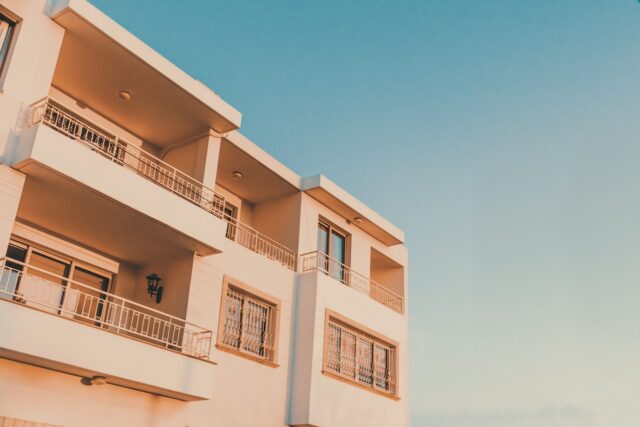

Seasonal Variations
The climate of Australia varies significantly from one season to another. Summers can be extremely hot, while winters can be cold in certain regions.
Thus, when planning an exterior painting project, one must take into account these seasonal variations to ensure the best application and longevity of the paint.
Regional Weather Differences
There are distinct regional weather patterns across Australia. The coastal areas are often humid, the central part is arid and hot, while the highland regions are cooler.
These differences can impact the choice of paint, the application process, and the drying time.
Impact of Weather on Exterior Painting
Weather significantly impacts the durability and appearance of exterior paint. High temperatures can cause the paint to dry too quickly, leading to cracks and peeling.
On the other hand, too much humidity can prevent the paint from adhering properly to the surface, causing it to blister and peel off.
Hence, understanding the weather patterns of your specific region is crucial to determine the best time for painting and the type of paint to use.
The Importance of Preparation
Preparation is key to a successful exterior painting project. It ensures that the paint adheres properly to the surface, resulting in a smoother finish and longer-lasting results.


Choosing the Right Time to Paint
Selecting the right time for the project is crucial. The ideal conditions for painting are mild temperatures, low humidity, and an overcast sky.
In Australia, spring and autumn are usually the best seasons for exterior painting.
Cleaning and Prepping the Surface
Before you start painting, it’s essential to clean and prepare the surface.
This involves removing any loose paint, dirt, and grime, repairing cracks and holes, and sanding the surface for better paint adhesion. A pressure washer can be a useful tool for this process.
Priming for Better Adhesion
Priming is a crucial step in the preparation process. A primer helps seal the surface and provides a suitable base for the paint, enhancing its adhesion and coverage.
This is especially important when painting over a darker colour or bare surface.
Selecting the Right Paint
Choosing the right paint can significantly impact the quality and durability of the exterior painting project. It’s important to consider various factors such as the type of paint, the sheen, and the colour.


Acrylic vs Oil-Based Paints
Acrylic and oil-based paints have their pros and cons. Acrylic paints are water-based, dry quickly, and are easy to clean up.
They are also more resistant to the effects of weather, making them a popular choice for exterior painting in Australia.
On the other hand, oil-based paints offer a smoother finish and are generally more durable, but they take longer to dry and require solvents for cleanup.
Your choice will depend on the specific requirements of your project and personal preferences.
Choosing the Right Sheen
The sheen or finish of the paint affects both the appearance and durability of the paint job.
Glossy finishes are more durable and easy to clean, making them suitable for high-traffic areas and surfaces that are prone to dirt and moisture.
On the other hand, flat or matte finishes hide surface imperfections better but are less durable.
UV-Resistant Paints for Australian Weather
Given the intensity of the Australian sun, UV-resistant paints are a great choice for exterior painting projects.
These paints contain additives that protect the colour and integrity of the paint from the damaging effects of the sun, ensuring longer-lasting results.
Environmental and Health Considerations
When selecting paint, it’s also essential to consider its environmental and health impacts. Look for paints with low volatile organic compounds (VOCs), which are safer for the environment and your health.
Also, consider the disposal of leftover paint, which can be harmful if not handled properly.
Painting Tools and Equipment
Having the right tools and equipment can make the painting process easier and more efficient. These include paintbrushes, rollers, paint sprayers, and safety gear.
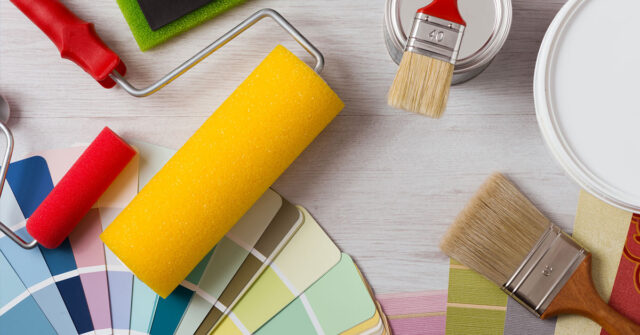

Brushes and Rollers
Brushes and rollers are the most common tools for painting. Brushes are great for detail work and smaller areas, while rollers cover large areas more quickly.
When choosing brushes and rollers, consider the type of paint you are using and the texture of the surface you are painting.
Paint Sprayers
Paint sprayers are another effective tool for exterior painting, especially for large projects. They provide a smooth, even finish and can save time and effort.
However, they require more preparation and clean-up, and there is a higher risk of overspray.
Safety Equipment
Safety should never be overlooked in any painting project.
Ensure you have safety glasses to protect your eyes, gloves to protect your hands, and a mask or respirator to prevent the inhalation of paint fumes and dust.
If you’ll be working at heights, make sure you have a sturdy ladder or scaffolding and always follow safety guidelines.
Painting Techniques
The right painting technique can significantly affect the final appearance and durability of the paint job. Whether you are using a brush, roller, or sprayer, it’s crucial to know how to use them effectively.
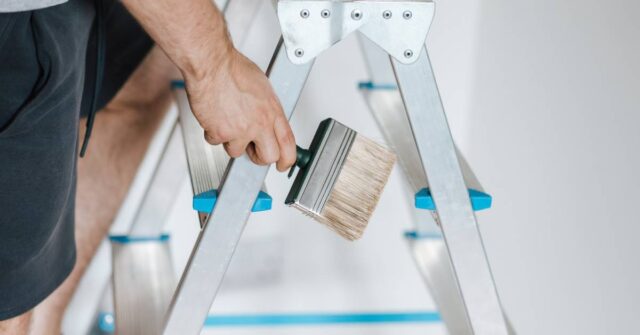

How to Use a Paintbrush
When using a paintbrush, dip half the bristles into the paint and then tap it against the side of the paint can to remove excess paint.
Apply the paint using smooth strokes, and always paint from dry to wet areas to prevent brush marks and streaks. Remember to clean your brush thoroughly after each use to maintain its condition.
How to Use a Paint Roller
When using a roller, roll it back and forth in the paint tray until it’s evenly coated with paint. Apply the paint in a ‘W’ pattern, then fill in the gaps without lifting the roller.
This technique ensures even coverage and helps to avoid roller marks.
How to Use a Paint Sprayer
When using a paint sprayer, start by testing the spray pattern on a piece of cardboard. Hold the sprayer a consistent distance from the surface and move it in smooth, even strokes.
Overlap each stroke by about half the width of the spray pattern to ensure even coverage. It’s important to wear a mask or respirator when using a sprayer to protect yourself from paint particles.
Special Techniques for Textured Surfaces
Textured surfaces can be a challenge to paint. For rough textures like stucco or brick, using a roller with a thick nap can help get paint into the crevices.
For very rough surfaces, a sprayer can be an effective tool. Always ensure the surface is clean and primed before painting for the best results.
Tips for Painting Different Exterior Materials
Every material has unique characteristics that can affect the way paint adheres to it. Here are some tips for painting different exterior materials.
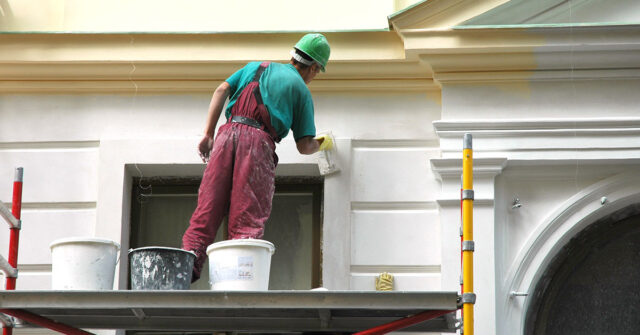

Painting Weatherboard
Weatherboard requires careful preparation to ensure a smooth finish. Start by cleaning the surface and scraping away any loose or peeling paint.
Prime any bare wood before painting, and always paint in the direction of the grain to ensure a smooth finish.
Painting Brick
Brick is a porous material, so it’s crucial to use a primer before painting to ensure proper paint adhesion. Use a roller or sprayer for the larger areas and a brush for the mortar lines.
Remember to clean the brick thoroughly before painting to remove any dirt or moss.
Painting Rendered Walls
Rendered walls can be painted much like any other surface, but it’s important to ensure the render is fully cured before painting.
Apply a primer to seal the surface and prevent the paint from soaking in. Use a long-nap roller to ensure the paint gets into all the nooks and crannies.
Painting Metal Surfaces
Metal surfaces should be properly cleaned and any rust should be removed before painting. Use a primer designed for metal to prevent rust and improve paint adhesion.
When painting, use a brush or roller for small areas and a sprayer for larger areas.
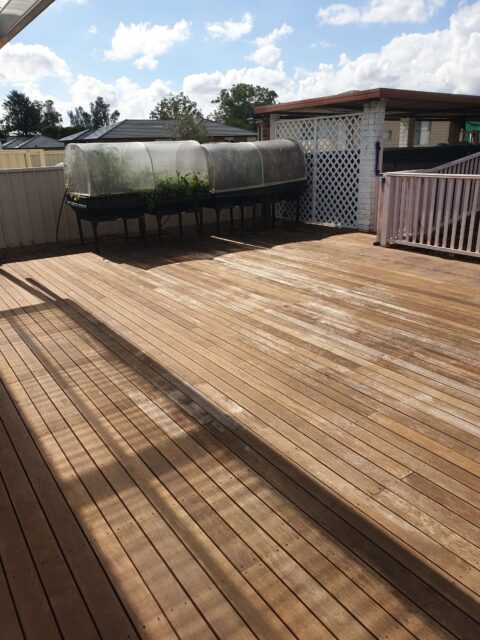

Painting Wood Surfaces
Wood surfaces require special attention to ensure a long-lasting paint job. Start by cleaning the surface and sanding any rough spots.
Apply a wood primer to seal the wood and prevent tannins from bleeding through the paint. When painting, follow the grain of the wood for a smooth finish.
Colour Considerations
Choosing the right colour can have a significant impact on the appearance of your property and can even influence its perceived value.
Here are some factors to consider when choosing a colour for your exterior painting project.
Understanding Colour Psychology
Colours can evoke certain emotions and influence perceptions. For example, light colours can make a building appear larger, while dark colours can make it seem smaller but more substantial.
Warm colours can evoke feelings of energy and optimism, while cool colours can convey a sense of calm and tranquillity.
Considering the Landscape and Architecture
The surrounding landscape and architectural style of your property should also influence your colour choice.
Choose colours that complement the natural surroundings and highlight the unique features of your property’s architecture.
Popular Exterior Colours in Australia
In Australia, popular exterior colours often reflect the natural environment. Earthy tones, shades of blue to reflect the coast, and greens for bushland settings are common.
However, your personal preference and the style of your home should always be your primary guides.
Remember, lighter colours tend to reflect heat, while darker colours absorb it, which can be an important consideration in Australia’s hot climate.
Maintaining Your Exterior Paintwork
Maintaining your exterior paintwork is crucial to keep it looking fresh and vibrant for longer. Regular cleaning and prompt repair of any damage can significantly extend the lifespan of your paint job.


Regular Cleaning
Regular cleaning can prevent the build-up of dirt, grime, and mould, which can deteriorate the paint over time.
Use a soft brush or low-pressure hose to clean the painted surfaces and ensure they are free of dust and debris. Avoid high-pressure washers as they can strip the paint off.
Checking for and Repairing Damage
Regularly inspect the paintwork for signs of damage like peeling, blistering, or chalking. If you notice such issues, address them promptly to prevent further deterioration.
This may involve scraping off loose paint, sanding, priming, and repainting the affected areas.
When to Repaint
The longevity of exterior paint can vary widely, depending on the quality of the paint, the preparation and application, and the weather conditions.
As a general rule, exterior paintwork should be redone every 7-10 years. However, if you notice signs of wear and tear like fading, chalking, or peeling, it may be time to repaint.
Understanding Australian Regulations and Standards for Exterior Painting
As with any building work, exterior painting in Australia is subject to certain regulations and standards.
These are designed to ensure the quality of the work, the safety of the workers and the public, and the environmental sustainability of the project.
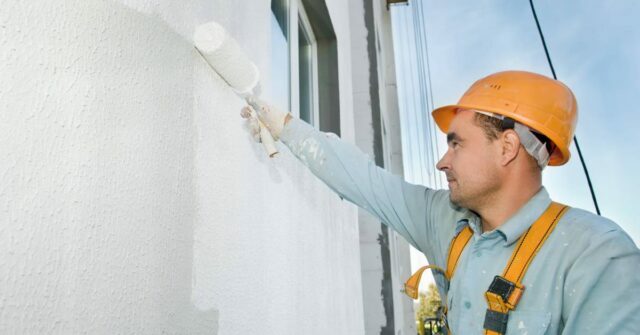

Local Council Regulations
Local council regulations may affect various aspects of your painting project, such as the colours you can use, especially in heritage conservation areas.
It’s always a good idea to check with your local council before starting your project to ensure you comply with any regulations.
Australian Standards for Paints and Painting
There are several Australian Standards related to paints and painting, covering areas like the classification of paints, the labelling of paint containers, and the preparation of surfaces.
These standards ensure the quality and safety of painting products and practices.
Environment and Safety Regulations
Environmental and safety regulations can also affect your painting project.
For example, there are regulations on the disposal of paint and painting equipment, the use of scaffolding, and the prevention of lead poisoning.
Always ensure that you comply with these regulations to protect your health and the environment.
Conclusion: Creating an Exterior that Stands the Test of Time
Exterior painting is a significant undertaking that can transform the appearance of your property and protect it from the elements.
By understanding the unique challenges of the Australian climate, making thoughtful choices about paint and equipment, using the right techniques, and adhering to regulations and standards, you can create an exterior that not only looks fantastic but also stands the test of time.


